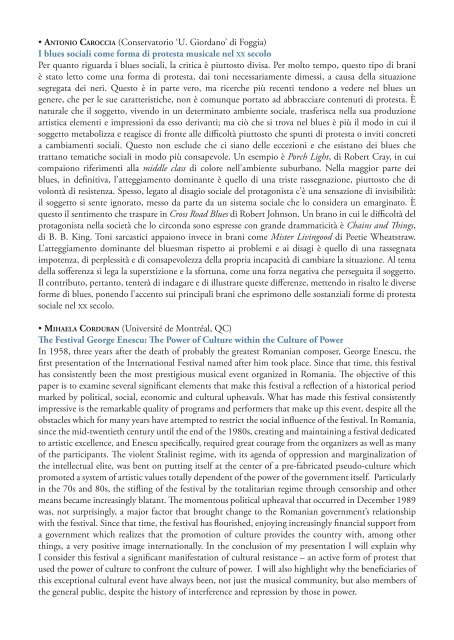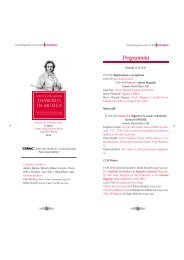PROGRAMME - Centro Studi Opera Omnia Luigi Boccherini
PROGRAMME - Centro Studi Opera Omnia Luigi Boccherini
PROGRAMME - Centro Studi Opera Omnia Luigi Boccherini
You also want an ePaper? Increase the reach of your titles
YUMPU automatically turns print PDFs into web optimized ePapers that Google loves.
• Antonio Caroccia (Conservatorio ‘U. Giordano’ di Foggia)I blues sociali come forma di protesta musicale nel xx secoloPer quanto riguarda i blues sociali, la critica è piuttosto divisa. Per molto tempo, questo tipo di braniè stato letto come una forma di protesta, dai toni necessariamente dimessi, a causa della situazionesegregata dei neri. Questo è in parte vero, ma ricerche più recenti tendono a vedere nel blues ungenere, che per le sue caratteristiche, non è comunque portato ad abbracciare contenuti di protesta. Ènaturale che il soggetto, vivendo in un determinato ambiente sociale, trasferisca nella sua produzioneartistica elementi e impressioni da esso derivanti; ma ciò che si trova nel blues è più il modo in cui ilsoggetto metabolizza e reagisce di fronte alle difficoltà piuttosto che spunti di protesta o inviti concretia cambiamenti sociali. Questo non esclude che ci siano delle eccezioni e che esistano dei blues chetrattano tematiche sociali in modo più consapevole. Un esempio è Porch Light, di Robert Cray, in cuicompaiono riferimenti alla middle class di colore nell’ambiente suburbano. Nella maggior parte deiblues, in definitiva, l’atteggiamento dominante è quello di una triste rassegnazione, piuttosto che divolontà di resistenza. Spesso, legato al disagio sociale del protagonista c’è una sensazione di invisibilità:il soggetto si sente ignorato, messo da parte da un sistema sociale che lo considera un emarginato. Èquesto il sentimento che traspare in Cross Road Blues di Robert Johnson. Un brano in cui le difficoltà delprotagonista nella società che lo circonda sono espresse con grande drammaticità è Chains and Things,di B. B. King. Toni sarcastici appaiono invece in brani come Mister Livingood di Peetie Wheatstraw.L’atteggiamento dominante del bluesman rispetto ai problemi e ai disagi è quello di una rassegnataimpotenza, di perplessità e di consapevolezza della propria incapacità di cambiare la situazione. Al temadella sofferenza si lega la superstizione e la sfortuna, come una forza negativa che perseguita il soggetto.Il contributo, pertanto, tenterà di indagare e di illustrare queste differenze, mettendo in risalto le diverseforme di blues, ponendo l’accento sui principali brani che esprimono delle sostanziali forme di protestasociale nel xx secolo.• Mihaela Corduban (Université de Montréal, QC)The Festival George Enescu: The Power of Culture within the Culture of PowerIn 1958, three years after the death of probably the greatest Romanian composer, George Enescu, thefirst presentation of the International Festival named after him took place. Since that time, this festivalhas consistently been the most prestigious musical event organized in Romania. The objective of thispaper is to examine several significant elements that make this festival a reflection of a historical periodmarked by political, social, economic and cultural upheavals. What has made this festival consistentlyimpressive is the remarkable quality of programs and performers that make up this event, despite all theobstacles which for many years have attempted to restrict the social influence of the festival. In Romania,since the mid-twentieth century until the end of the 1980s, creating and maintaining a festival dedicatedto artistic excellence, and Enescu specifically, required great courage from the organizers as well as manyof the participants. The violent Stalinist regime, with its agenda of oppression and marginalization ofthe intellectual elite, was bent on putting itself at the center of a pre-fabricated pseudo-culture whichpromoted a system of artistic values totally dependent of the power of the government itself. Particularlyin the 70s and 80s, the stifling of the festival by the totalitarian regime through censorship and othermeans became increasingly blatant. The momentous political upheaval that occurred in December 1989was, not surprisingly, a major factor that brought change to the Romanian government’s relationshipwith the festival. Since that time, the festival has flourished, enjoying increasingly financial support froma government which realizes that the promotion of culture provides the country with, among otherthings, a very positive image internationally. In the conclusion of my presentation I will explain whyI consider this festival a significant manifestation of cultural resistance – an active form of protest thatused the power of culture to confront the culture of power. I will also highlight why the beneficiaries ofthis exceptional cultural event have always been, not just the musical community, but also members ofthe general public, despite the history of interference and repression by those in power.









